This eight-page issue published for June of 1962 starts with the movie Hatari! Pages two and three are all about dealers (and some love for Tornado engines). Most of pages four through seven cover more Hatari info. Page eight highlights the seventh annual Truth or Consequences (NM) ‘Jeep’ Derby. I plan to go back at some point and figure out when the ‘Jeep’ News began covering club and race information. At some point during the late 1950s – early 1960s the notion of jeeps as “fun”, rather than just utility workhorses, enters both the ‘Jeep’ news and Jeep’s advertising. I’m want to learn more about that subtle shift.
6 Comments on “June 1962 Jeep News”
Leave a Reply
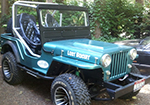
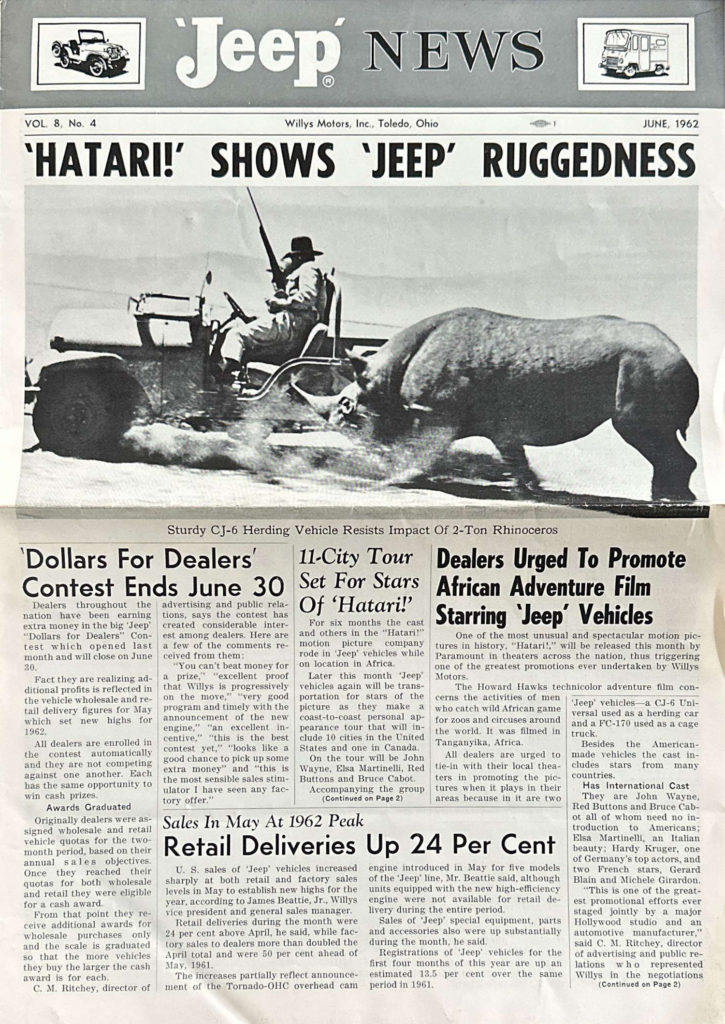
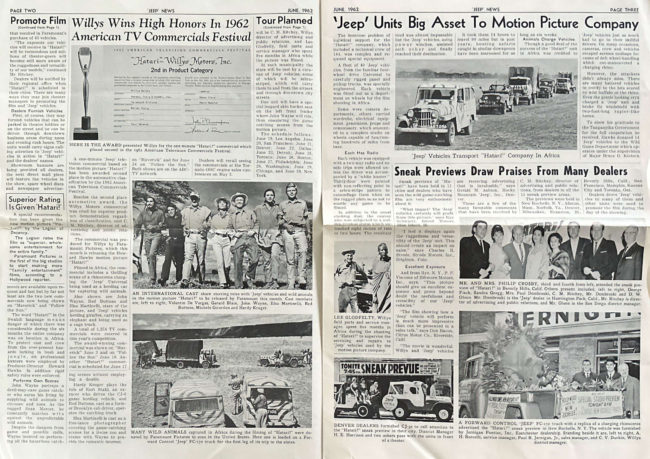
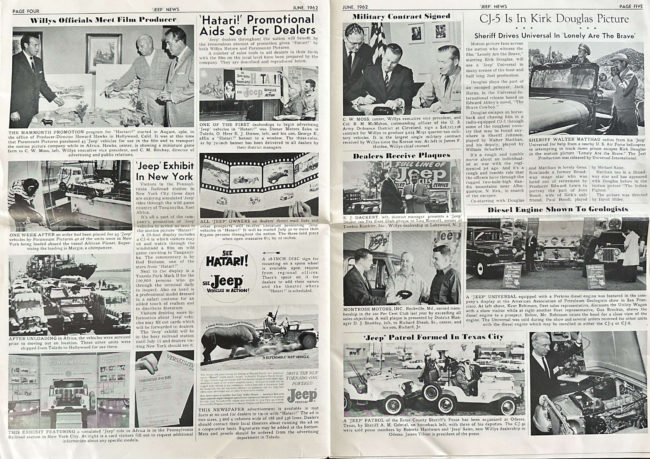
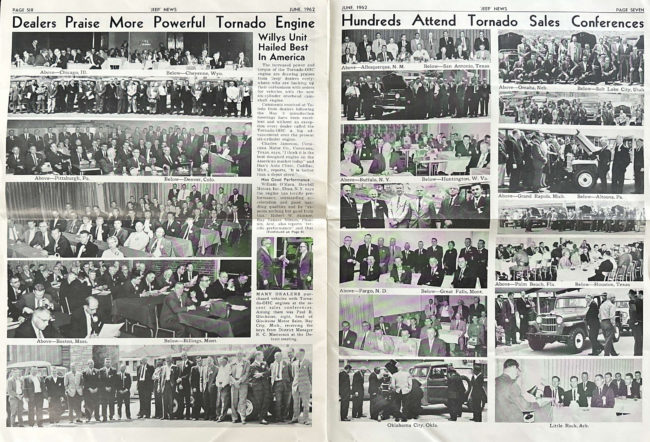
Page 5 shows a Perkins diesel in a CJ. I’ll take one!
Dave
“At some point during the late 1950s – early 1960s the notion of jeeps as “fun”, rather than just utility workhorses, enters both the ‘Jeep’ news and Jeep’s advertising. I’m want to learn more about that subtle shift.”
I would LOVE to read your findings.
Today in Automotive journalism, we hear a lot about how SUVs came to rule today’s marketplace.
We also hear a lot about expensive classic/vintage SUVs and why they’re so popular.
Arguably Jeep led.the way in putting “sports” in sports utility vehicles…
The Renegade, the Super Jeep, and in creating the dual use market with the ’60s Jeepsteer and Tuxedo Park versions.
And then, they can be credited with creating what we call the SUV, (remember, the Suburban was just a pickup with a wagon body grafted on the back of a pickup cab), with the original 4×4 Wagon, and of course the ’60s Wagoneer…which they later turned into a luxury vehicle.
With your writing talents and research resources, you could do a great story (or series) on the topic.
I would encourage you to shop it around to get it the largest readership (and perhaps a few bucks).
John,
In my mind, off the cuff, fleshing out a quality article would require specific definitions of “Sport”, “Utility”, “SUV”, and “Fun”. Now, without trying to absolutely solve those terms, arguably, any pre-WWII vehicle used for both utility (carrying hay for cattle or for mining or many other uses) and sport (hunting or fishing) should quality as a sport-utility vehicle, as it satisfies both definitions technically, but did the 2WD pre-war truck, car or wagon count as an SUV? Circularly, it depends on how we define that term (perhaps 4WD vehicle, covered back, two rows of seats, and?).
And then, how does “Fun” enter into the equation? Near the end of WWII, jeeps were performing in Army shows, they were used competitions when teams raced against one another to assemble them, there were some early racing competitions, there were early clubs (Yakima and Socal), where folks were using them for travel pleasure over rough terrain, aka jeeping.
To me, this is where changing post-war demographics may well help tell the story of the jeep. My guess is that as family farms disappeared post war, the demand for jeeps on the farm decreased; meanwhile, ex-farmers moved to suburbs, the need for utility vehicles increased (carry stuff, tow small trailers, handle suburban kinds of tasks). As the middle class grew during the 1950s, did this free up more time for activities folks to use their utility vehicles for more social activities, like jeep clubs, jeeping, and other SUV friendly activities? For many folks in early jeep clubs, jeeps gave them a way to explore formerly remote, inaccessible areas.
And, a question I have no answer for yet … by the mid-1950s many of the WWII vets were likely in financial positions to afford to buy a jeep as a second vehicle and also afford weekend excursions for sport (whether jeeping, hunting, fishing, or other off road activities). They could relive some of their jeep experiences in these newer, more roomy and comfortable CJ-5s, wagons, and trucks. How did this factor into the SUV mindset?
What these Willys News and Jeep News articles can help gauge is when Willys Motors picked up on the “fun” aspect and, eventually, began marketing to it. ,, More to say, but cows need feeding, lol …
Dave, another important part of the equation may be how the government looked at it – on both a national (DOT) and state level (BMV). Seems I remember older Jeeps and into the 70s were classified by BMVs as Multi Purpose Vehicles (MPVs) and that this is one way they skirted the 5 mph bumpers of 1973 as well as the lag behind of some safety features such as seat belts . What you well laid out above outlines the evolution of the MPVs to the SUVs. At the bottom of the serial number decal on the dash of our ’71 CJ (see Right hand ads, bottom) it reads, TYPE: MULTI PURPOSE PASSENGER VEHICLE, a phrase I believe is found on CJs perhaps to the end of the run. I believe the definition of an MPV is essentially a passenger vehicle on a truck frame. I also remember title clerks and registrars asking if my (CJ) had a back seat, and if not , wanting to declare it a truck.
Thanks Barney. I didn’t know about the MPV issue nor the 5mph bumper/safety issues, but that all adds color and depth to any analysis. Finally, that back seat issue is pretty interesting as well. I never encountered that with my jeep back in the early 1980s. But, that was WA State.
– Dave
Last time I encountered the back seat issue was about 15 years ago. I bought an 84 Chevy D10 CUCV Blazer and was asked if it had a back seat. Since Blazers, Cherokees etc were available without back seats, perhaps the Ohio system was programed to differentiate.